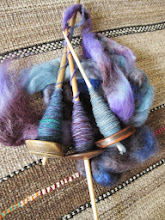Why so excited? I'm not even sure, but there's something deep and moving about taking up the simplest backstrap arrangement, and creating something complex, logical, and ancient in its applications.
Thanks to Laverne's book and blog, and her ever-helpful and instructive presence on Ravelry, I have indeed begun to learn pebble weave. Above is my first (actually, second) attempt, a double pebble with 8 warps instead of four because I tend to mis-count warps while measuring them out. The next one became a key fob, which my husband needed and appreciates.
After these, I set out on more complex 8-warp designs. These alternate the basic pebble with "design rows" which create a new pattern. That's the part I find ingenious - alternate the same pattern, and just vary what you do in between, and you can get this:
or this:
The red & green above thrills me because it's so common in traditional textiles from Peru (see the logo motif) and Bolivia, which I've admired since I first worked in an import shop 20 years ago. To have at least scratched the surface of understanding how they are made is so fulfilling. When I look at pages from the Museo de Arte Indigena calendar that a friend bought in Bolivia, I see the weaving in a completely new way now, because I can identify the technique, and in a very few cases I could reproduce it in rough form.
Now I'm eager to learn some of the complicated, curly ones, or possibly the beautiful design Laverne did in handspun llama. Then of course, I need to spin some natural-dyed wool to make it more authentic and beautiful..... This is the path my current reveries take.
I have progressed beyond the one-inch strap, and composed a little piece with two different designs - it's the first image in this post, and here's how it was set up.
It differs from the narrow strips in the use of a backstrap bar, with a needle lashed on to control that edge, and also in the use of string heddles for the plainweave segments:
The pebble designs on the sides do not show up here because I only used blue and white, but the backside shows them well.
Is that exciting or WHAT?
(I try to make sure the blog is not about the blog, but I have to say, the formatting on here makes me nutty, and that's why you usually see a column of centered photos with no variation of size or placement. I've also vowed not to spend too much time messing with the blog, so it will probably be this way for a while, until the system is improved or I get zapped with sudden tech knowledge. Maybe I should have said nothing, and let everyone think it's a design choice. Oh well.)













2 comments:
Lovely straps! These woven straps
can be found in so many cultures - here(http://www.gewebte-baender.de/wickelkind.html) they were used to rock a cradle. Some were tied around the belly of women about to give birth, a process also called "de-bind" in German! In the 50s one was still able to buy them. The Fortune Knot "Sigurlykkja" is from Iceland, a knot that brought good fortune to all females, be they human or animal, for giving birth. In the 1960s, we had the good fortune to watch(Navajo) Diné sash belt weaving on a lap loom - all very reminiscent to your wonderfully woven shashes - I do understand your excitement and will add a few mental exclamation marks! Thank you for this very interesting blog.
Continue to concentrate on the lovely structure and composition of the fabric you are creating. Really, if a blog was meant to display the artistic, aesthetic and photo-skilled elements of an artist whose main work involves yarn and wool, wouldn't it have reflected this high skill level and not call itself "blog?" Maybe museum or treasure house or palace of art.
I think of blogs as the electronic equivalent of chatting over neighborhood fences and sharing the excitement one's creativity can produce. This media form is just the mailbox; the message in the text, photos, videos is the real thing. And yours, by the way, captures light and urges a squeeze, a stroke, a project!!
Cheer up! We get it!
Mary
In the mid-Hudson Valley, NY
Post a Comment